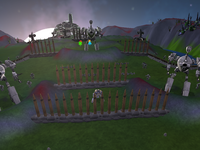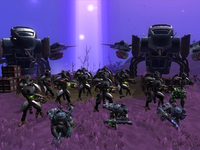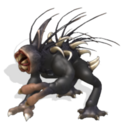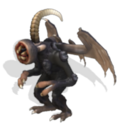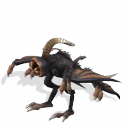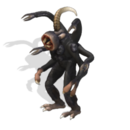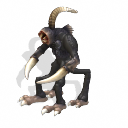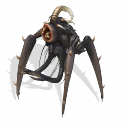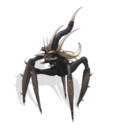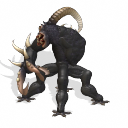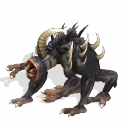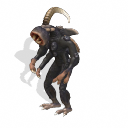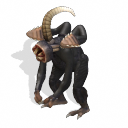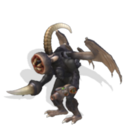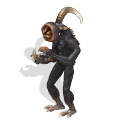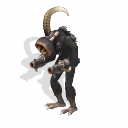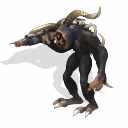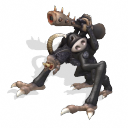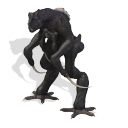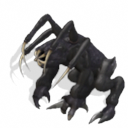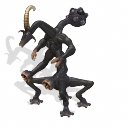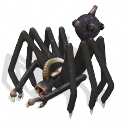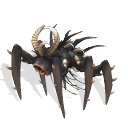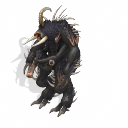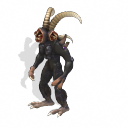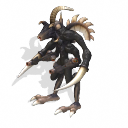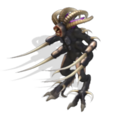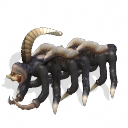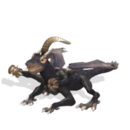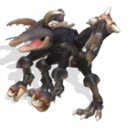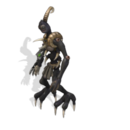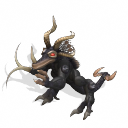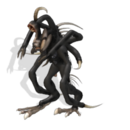Xenochytrid
| Xenochytrid | |
| 260px | |
| Summary | |
|---|---|
| Homeworld | N/A |
| Notable for | Biology, adaptability, numbers |
| Strengths | Specific strengths vary between Hives, but all are known for their vast numbers and ability to adapt to almost any situation. |
| Weaknesses | Typically weak on an individual level. Require constant biomass to sustain themselves. Majority of forces express little to no strategic ability. |
| Leadership | |
| Government | Hivemind |
| Known Hives | Four |
| Statistics | |
| Population | Innumerable |
| Technology | Bioengineered equipment and assimilated machinery. |
| Size | Unknown |
Xenochytrid, also known as XE-CH, are an aggressive bio-mechanical species of unknown origin. Comprised of a substance known as biomass which resides in vast, living communities known as 'hives', xenochytrid travel from planet to planet like an organic tsunami, consuming all organic matter in their wake so as to grow and evolve. Though seemingly incapable of creating conventional technology, the hives make use of bioengineering to produce various organic tools and weapons and can integrate machinery into themselves, allowing xenochytrid to make use of starships, their primary form of transportation between planets, as well as vehicles, weapons, and other forms of technology. Incapable or unwilling to reason, xenochytrid are hostile to all non-Xenochytrid life and attack anything and everything indiscriminately, making them a threat to all life in the known galaxy.
Xenochytrid were first identified several decades before the start of the Great War when a spore of Hive Fafnir crashed upon and swiftly overwhelmed a small research colony. In the years that would follow, several hives, including Apophis, Piru, Cronen, and Tiamat, would be identified in various locations across the region. Due to their slow and gradual advance, the Xenochytrids were considered a minor threat by most of the major powers that would eventually become the Peacekeeper's and Warlords. This changed with the Infestation of Rotunin, in which billions perished following the infestation of a heavily-defended and urbanized colony. In the aftermath of Rotunin, several dedicated task-forces would be created to combat the threat, most notably the Anti-Xenochytrid Task Force, which to this day continues the fight against the swarms even as the Great War intensifies.
History[edit | edit source]
The origins of theXenochytrid are a matter of intense debate among scientist and historians across the interstellar community; multiple theories have been proposed over the years in an effort to explain where and how they came to be, but without any conclusive evidence, they have proven impossible to confirm with any certainty. The popular theory is that the swarms were created artificially by an alien race and were either set loose on purpose or breached containment and escaped. Many modern empires have been accused of creating the hives as superweapons, though these accusations have been rejected in all cases. Others believe that the Xenochytrid evolved under very specific circumstances, but as no taxonomical equivalent has been discovered, this is rejected by many xenobiologists. Extragalactic origins have also been proposed, as has the Abyssal Space.
Certain groups have taken a more superstitious view of the Xenochytrids, believing them to be demons or evil spirits that have materialized in the material realm. Some Repzork hold to the belief that the Xenochytrids are connected to the Nygalara, an ancient monster of the Oltavaran Faith that is said to be working to undo creation. The Virisus of the Cult of Legion are a notable exception, claiming instead that the Xenochytrids are benevolent beings that seek to unite and uplift the galaxy as one harmonious consciousness in service to their god, Legion. This cult would play an instrumental role during the Necraal Schism and continues to operate from the shadows, spreading the Xenochytrids wherever they roam. Whether Legion was a figment of Hor'or's imagination, a leader of one of the hives, or even a supreme organism that controls the hives, remains unknown. Other cults have emerged elsewhere in the fringe regions of interstellar space, some going as far as to propagate infestations and sacrificing individuals to their gods.
Notable Encounters[edit | edit source]
Pre-Great War[edit | edit source]
Encounter Codename: Outbreak
The earliest recorded Xenochytrid outbreak occurred decades before the start of the Great War when a spore of Hive Fafnir crashed upon Mitacen, a colony of the Mardle Empire. While the spore was still dormant, Research Base 738 sent out a team of scientists to gather samples of the then-unknown organisms for study. Shortly after the samples were brought back to the facility, the Xenochytrids, including the samples, became active, leading to the deaths of much of the facility's staff. Xenochytrids from the spore soon attacked and overwhelmed the facility, as well as a nearby settlement, killing all but a handful of colonist who managed to escape on a cargo ship. The Mardle initially attempted to cover up the incident, but subsequent attacks by Fafnir on nearby colonies made concealment impossible, and other empires soon began efforts to study the new alien threat.
Encounter Codename: Gauntlet
A spore landed near the capitol of the Flewrit colony of Qualiot, prompting the colonist to send a mercenary to investigate the crash site. By the time the mercenary arrived, the swarm had already produced a sizeable colony with numerous maturing birthers. Dozens of warriors emerged to attack the mercenary, who narrowly escaped in time to warn the Flewrits. Hours away from reinforcements and lacking the manpower necessary to eliminate the hive, the Flewrits evacuated the planet. Much of the populace managed to escape, though Qualiot itself was deemed a total loss.
Encounter Codename: Laboratory
Three weeks after the fall of Qualiot, the Salatrans began studying the Xenochytrids in the hopes of uncovering a weakness. They recovered samples various colonies and brought them to a facility on Phytaurs. Not long after they were brought to the facility, several mutariors escaped and infected both researchers and other creatures being held within the facility, leading to an outbreak. Before the creatures could escape the facility, a lockdown was initiated, though at the cost of most of the facility's staff. Instead of immediately destroying the facility, the Salatrans decided to observe the Xenochytridsthrough what remained of the installation's camera systems while maintaining a strict perimeter around the base. The information gathered from these observations would later be provided to the fledgling Peacekeeper Alliance, which was established less than two weeks later. After a month of observation, the installation, and all Xenochytrids within, were terminated.
Encounter Codename: Blight
A derelict frigate seeded with a spore from the Tiamat hive crashed on the Repzork frontier colony of Nalg-11. Repzork forces were caught completely by surprise by the infestation, leading to the fall of two nearby outposts. A distress signal was sent out while the defenders held their ground for as long as possible. Fortunately for the Repzork, the freezing conditions and limited biomass in the area hindered Tiamat's efforts to grow, and the hive was soon unable to replenish its losses. Repzork forces then rallied and pushed the Xenochytrids back to their landing site, quickly destroying the hive with whatever weapons they had available. Reinforcements arrived roughly an hour later and promptly quarantined the planet and all personnel as they began investigating the swarms.
In the months that followed, more planets fell under attack by Tiamat, prompting Imperial Command to assign the 500th 'Purity of Flames' armada with the task of purging the infestation. Sector 05-4, also known as Quarantine Zone Black, the sector containing all planets known to have been attacked by the Xenochytrids, was established thereafter, and all civilians were evacuated as the 500th went on the offensive.
Great War Era[edit | edit source]
Year 2[edit | edit source]
Encounter Codename: Assault
What would become the first major engagement between Peacekeeper forces and the Xenochytrids occurred two years after the start of the Great War on the sparsely-populated Minomit colony of Ozelion. A cruiser with a spore from Fafnir crashed in a lush jungle near the planet's environment. The nearby biomass allowed for a large colony to develop at an unprecedented pace. The colony was evacuated by a nearby WBI fleet that beamed down all of its forces for a last-ditch effort to save the planet. After a lenghty engagement that saw the destruction of most of the defenders, air support arrived, enabling the Minomits to establish a perimeter around the hive, which was then destroyed by an orbital strike, ending the infestation and marking the first known victory against the swarms.
Encounter Codename: World Eater
As the First Battle of Aserai was underway, the Dragoneteran colony of Dralix ceased communications. Believing the blackout to have been caused by the Zaretians, the Dragoneterans sent a small force to the planet once Aserai had been secured, they instead discovered that the planet had been overwhelmed by the Xenochytrids. Several teams were sent down to search for survivors. All of the ships soon vanished, but were later spotted attempting to leave, only to be shot down when they did not respond to communication requests. One of the teams soon reestablished contact, stating that they had been pulled down by a tendril and needed extraction. A team was sent down and successfully recovered the team. The planet was subsequently quarantined, but rather than bombing it, the king decided to keep the colony for study. ( I know we Retconned this event but I would like to propse we keep it. Will talk about at the next meeting I attend -Chu)
Encounter Codename: Ractia Infestation
Several Xenochytrid spores landed on the Kastalian colony of Ractia in quick secession, sparking a widespread infestation. A distress signal was sent out and was soon answered by a mercenary who agreed to provide assistance to the Kastalians. Despite the defenders having vastly superior armor and weapons, the Xenochytrids were simply far too numerous for them to contain. After defending themselves against countless waves of warriors, reinforcements arrived and evacuated the surviving Kastalians.
Year 3[edit | edit source]
Encounter Codename: A Need for a Virus
During the Dragoneteran-Tegotian War, the Dragoneterans discovered that the Tegotians were establishing a base within Monarchy territory. With most of their troops already on the front lines or defending the core worlds, the Monarchy looked into weaponizing the Xenochytrids. Using samples gathered from Dralix, Feverclan, and other infected planets, they developed an airborne virus that could mutate organic matter into Xenochytrid organisms. A spy successfully infiltrated the Tegotian compound and deployed the virus, which created a much larger infestation than was initially intended. Several spores escaped, infecting other Tegotian-occupied colonies, delaying Tegotian forces for several weeks.
The incident remains the first and so far only time that a Peacekeeper has weaponized the Xenochytrids. The Dragoneterans initially attempted to hide their involvement, but were soon found out and condemned by the Peacekeepers. The monarchy destroyed the remaining virus samples and all research pertaining to the project. The use of the Xenochytrids as a weapon was thereafter banned. In the weeks that followed, it was noted that certain Hives, notably Apophis and Fafnir, were using a virus similar in nature to the Dragoneteran weapon, leading many to believe that the hives had successfully integrated the virus into their biology.
Year 4[edit | edit source]
Encounter Codename: Turn on You
A Cronen spore landed near the Skrey outpost of Heatwave, which was located on one of the Skrey's arid colonies. Not knowing what the Xenochytrids were at the time, the Skrey sent out a scouting team to investigate. The scouts were promptly attacked, though some managed to escape back to the outpost. The Skey attempted to hold back against the swarm, but were quickly outnumbered and overwhelmed, the survivors escaping on a Behemoth transport. Though the planet was lost, the primitive nature of most Skrey vessels made it difficult for Cronen to spread, preventing a full-scale infestation within Skrey territory.
Encounter Codename: Contract
Amid an ongoing skirmish between the Skrey and Cronen on the planet of Eghan, a Repzork fleet, which had been secretly monitoring the Skrey since their attack on a WBI colony several months prior, stepped in to assist the Skrey. Though unwilling to receive their help, the Skrey begrudgingly accepted their offer. The two forces successfully eliminated the hive shortly thereafter. The Repzork used the opportunity to get in touch with the leaders of Tazorag, the ruling Skrey clan, and after lengthy negotiations, inducted the Skrey into the Warlord Pact.
Encounter Codename: Survival
A major turning point in the growing fight against the Xenochytrids occurred at Rotunin, a wealthy corporate colony that was located in neutral space. Though its dealings with both Peacekeeper and Warlord officials made an invasion by either side unlikely, the planet still maintained formidable defenses, including a private army and anti-orbital batteries, which led officials to believe that the planet was immune to all but a large-scale invasion. Their sense of security was shattered when a carrier containing a massive spore of Fafnir began approaching the planet. Though orbital defenses had managed to break the ship apart, this only resulted in a shotgun-like effect that spread Xenochytrids across a much wider area than it would have otherwise. The densely-packed ecumenopolis provided more than enough biomass for Piru to establish a sizeable colony. Panic swept across the planet as civilians attempting to flee, clogging the streets and making colonists easy prey for the swarms. Unable to stem the tide, the defenders abandoned the planet, which was bombarded a few days later.
News of Rotunin's destruction swept through both Peacekeeper and Warlord channels. It was at the time the largest and bloodiest infestation to date, with many estimating that billions had died over the course of the attack. It shattered the notion that the Xenochytrids were only a threat to lightly-defended colonies, prompting civilians and public officials across the region to push for their nations to devote more resources to combating the swarms. Within the Peacekeeper Alliance, the destruction of the Xenochytrids became a part of their mission to protect the weak, and deliberations began as to how to best handle the crisis.
After several days of deliberations, the Peacekeepers founded the Anti-Xenochytrids Task Force, or AXTF, with the goal of protecting Peacekeeper and neutral colonies from the swarms. Drawing troops and equipment from most of the Alliance's members, the AXTF's diverse arsenal allows it to combat the Xenochytrids no matter the circumstances. Since its inception, the ABTF has proven instrumental in curtailing the swarm's spread, with many planets having been saved by their efforts.
The creation of the ABTF has since led to many copy-cat groups forming. These are generally located in neutral space and accept members from both Peacekeeper and Warlord powers. With less funding and equipment, many such groups have collapsed shortly after their creation; however, a few have survived and have risen into prominence, though they still cannot compare to the ABTF.
Year 8[edit | edit source]
Encounter Codename: Judgement Day
The AXTF's mettle was tested when a spore from Fafnir landed on a colony deep within Diab territory. With most of the AXTF's forces elsewhere, it was up to a local Diab contingent to contain the infestation, which had already established a foothold on the planet. Within the contingent was a small group of Diab bio-troopers, namely Specialist Heimdall, widely considered to be one of the best specialist the empire has to offer. After fighting through the colony, Heimdall successfully infiltrated the hive and planted a bomb inside the hive, destroying the hive and ending the infestation.
Encounter Codename: Orbital
The Zaretian colony of Hilshir was attacked by a never-before-seen 'organic battleship' from which hundreds of organisms emerged. The Zaretian defenders fought back, but quickly discovered that many of the vessels systems, including the shields and some of the gun batteries, remained operational. The combined assault of the vessel and the growing swarm of Xenochytrids overwhelmed the unprepared defenders, who were forced to cede the planet.
Year 10[edit | edit source]
Encounter Codename: The Horror
Taldrin was a small Acropolan colony located on the fringes of their empire. Far from the Great War and the Conkirites, the planet was lightly-defended and was considered to be of little priority. This would ultimately prove to be its downfall when Apophis attacked the colony. Unable to repel the invaders, the colony was soon overran, leading to the deaths of most of the planet's population.
Year 11[edit | edit source]
Encounter Codename: Sentience
A Fafnir spore landed on the Flytal colony of Yintil. The governor sent a distress signal and received a swift response from the ABTF, who arrived in time to prevent the swarm from overwhelming the colony. A pitched battle ensued, with the Xenochytrids slowly being pushed back until the sudden arrival of infected Necraal. The Necraal, who had somehow retained their sanity despite their condition, outmaneuvered and routed the panicked task-force, who suffered heavy casualties as they were repelled from the planet.
The attack caused media hysteria and baffled Peacekeepers and Warlords alike. Similar attacks soon took place elsewhere, casting suspicions upon the Necraal, who denied any involvement. Their suspicions were confirmed with Necraal scientists defected and revealed that King Hor'or had begun worshiping an entity known as Legion and had been splicing Xenochytrids and Necraal DNA to create hybrid soldiers. These revelations led Crown Prince Bael'thir Anduish'ent'mar to instigate a coup against his father with the aid of the Pact.
The ensuing civil war would see the majority of the AXTF deployed to Necraal space to assist in containment efforts as Hor'or began to use the Xenochytrids against invading Warlord and Peacekeeper armies. This culminated in the Battle of Ivn, where Hor'or deployed dozens of spores across the Necraal homeworld, producing the largest infestation in known history. Though the ABTF evacuated thousands of Necraal, they and the Warlords were unable to save the planet, which had to be bombarded into a lifeless husk.
The ABTF suffered heavy casualties over the course of the campaign, putting much of the task force out of commission for months as they rebuilt their strength. Those who were still at operational strength would begin efforts to hunt down the newly-formed Virisus and monitor planets surrounding Necraal space for any signs of infestation. Observers would soon note that some Xenochytrid organisms had seemingly begun developing psychic powers similar to those of the Necraal.
Encounter Codename: Crystalline Horror
A Delani expeditionary fleet came across a massive deposit of valuable resources on an unnamed planet in the far reaches of their territory. Four fire teams were sent down to the planet's surface. Unbeknownst to them, a Xenochytrid colony laid dormant beneath the surface, and awoke upon sensing the intruders. Three of the four terms were overhelmed, with the final group narrowly evacuating the planet.
Year 12[edit | edit source]
Encounter Codename: Hunted
A spore of Piru landed on a sizeable Nepharian colony. Initially, the Nepharians appeared victorious; the spore was quickly contained and destroyed. In truth, some of the Xenochytrids had survived by burying themselves deep underground. As the hive festered, mutariors moved to the surface and infected several individuals, but did so in a way that showed no outward symptoms. This allowed the host to gather near strategic locations undetected. It was then that the hive launched a second attack, emerging directly into the colony's capital. With the aid of their infected hosts, the XenochytridS were able to subdue the city's defenders, and eventually, the planet.
Encounter Codename: The Biological Assault
An Aeverian colony fell under attack by the swarms of Apophis. The ABTF soon arrived to combat the threat, and after suffering considerable losses while evacuating the colonist, bombarded the swarms from orbit. Once the hive had been sufficiently suppressed, ground forces were deployed to eliminate stragglers. After over three weeks of continued engagements with surviving elements of the hive, the planet was deemed safe for recolonization.
Biology[edit | edit source]
All Xenochytrids are comprised of billions of microscopic organisms collectively referred to as biomass. Under normal circumstances, biomass is inert, typically appearing as a black, semi-solid substance with no defined shape. When exposed to organic matter, the biomass becomes active, and exhibits behavior similar to that of terran slime molds; individual cells will join together to form a single, conscious organism. Each biomass cell contains the genomes of tens of thousands of species whose genetic material has been assimilated in the swarm and modified to suit the swarm's needs, sometimes to the point that the progenitor is impossible to identify. This extreme degree of genetic diversity allows biomass to form into one of many hundreds of different Xenochytrid varieties and further modify them to suit specific situations. Xenochytrids can range in size from a balled fist to skyscrapers and can take both animalistic or humanoid forms.
As well as various 'natural' adaptations such as extra appendages, wings, claws, or a carapace, biomass is capable of creating biological replicas of various tools and weapons used by sapient races. These adaptations can range from razor-sharp bone swords to 'bioguns' which propel acid or spikes towards their target. Additionally, the Xenochytrids are capable of interfacing with and integrating technology into themselves. This allows the Xenochytrids to make use of guns and vehicles, up to and including starships, which act as their primary form of transportation between planets, though they are seemingly incapable of producing said equipment themselves. Most researchers believe that the Xenochytrids learned how to produce organic tools by constantly integrating their mechanical counterparts. It remains uncertain to what extent the Xenochytrids can replicate sentient technology.
Xenochytrid colonies revolve around birthers, large structures from which emerge the various organisms that protect and feed the birthers. Individual birthers are connected to one another by tendrils, forming vast 'cities' that can encompass an immense area. Birthers also produce roots that dig deep into the earth to siphon water and minerals to help sustain the hive. Colonies require a steady supply of biomass in order to expand their reach and create more organisms. To meet this need, the Xenochytrids have created numerous 'feeder' creatures which travel behind warriors and consume the dead, including deceased Xenochytrids, and any other organic matter they come across. These materials are converted into biomass which is then regurgitated back into the colony. Though most feeders are not designed for combat, some are, and often make use of powerful spiked appendages to pull prey into their maws.
The Xenochytrids can mutate living organisms into infected hosts through a variety of methods. Foremost among them is the Mutarior, a small, worm-like creature that digs into a target and hijacks its nervous system while pumping the host body with mutagenic cells. Infected hosts generally support the warrior organisms and often have unique mutations derived from their biology. A variant mutarior can also be shot out of a biogun. Birthers and certain organisms can also produce an airborne virus similar to the one utilized by the Dragoneterans against the Tegotians, though it is easily scrubbed by air filters.
The intelligence of the Xenochytrids has proven impossible to determine. While basic organisms generally express little to no tactical thinking and have no regard for their own well-being, more advanced specimens can perform complex maneuvers and sometimes possesses a modicum of self-preservation. Biomass can reliably use integrated technology and, most notably, can utilize the faster-than-light engines of a starship and a ship's navigation data to pinpoint planets ripe for colonization. At the same time, the Xenochytrids have never been shown to communicate with outsiders and have no culture to speak of. Their behavior has often been compared to that of insects such as ants or basic computer A.Is that can perform only a set number of tasks, which many interpret as evidence that the hives are an artificial creation.
Though every Xenochytrid organism is by and large expendable, many are more resilient than is generally perceived. Due to their cellular makeup, organisms can lose a large percentage of body mass and survive so long as they retain their cranium and are capable of limited locomotion. Additionally, many organisms boast bullet-resistant hides and/or biological armor and possess limited regenerative abilities, especially when near birthers. The most effective weapons against the swarms are those that prevent regeneration and destroy large portions of the creatures' body at once, such as explosive ammunition, plasma, acid, and fire. Biological weapons have proven almost entirely ineffective in the long-term as the creatures rapidly adapt to viruses and bacteria.
Xenochytrids have thus far shown aggression to all non-Xenochytrid lifeforms with the sole exception of the Virisus, Necraal whose DNA was spliced with that of Biomass. Based on documents leaked by Necraal who had defected from the hybridization program as well as field reports from various ABTF operatives, the Xenochytrids show no deliberate aggression towards the Virisus, instead treating them as they would any other Xenochytrid organism. Necraal documents also claim that many Virisus would feel homicidal urges or a desire to consume non-Virisus and felt as though they were being watched at all times. Many Virisus would attempt to resist these urges, but found it more difficult as time progressed. Those who gave in had a tendency to gradually lose their sanity, occasionally reverting to an animalistic mindset. Due to the difficulty retrieving live Virisus for study, research into this phenomenon was limited until the return of Crown Prince Bael'thir and the subsequent schism within the Virisus' ranks.
Planetary Assimilation[edit | edit source]
The process of 'colonizing' a planet begins when a spore -a starship loaded with a large amount of biomass- crashes upon the planet's surface. The once-dormant biomass then activates and begins producing birthers and Xenochytrids. The Xenochytrids travel around the crash site to eliminate any resistance and gather material for the fledgling hive. This state is where the Xenochytrids are at their most vulnerable, as depending on the colony and the size of the spore, they are unlikely to have the numbers sufficient to overwhelm the inhabitants.
Once the Xenochytrids have established a sizeable colony, the next phase begins. The birthers begin pouring out hordes of warriors and feeders to spread across the region. As the warriors fight the planet's inhabitants, birthers gather more organic material and begin establishing new birther colonies. The colonies begin reaching into the earth and absorbing materials as specialized organisms begin carving out a network of tunnels. Some of these tunnels are dug beneath enemy positions to assist the warriors. All the while, the birthers emit a toxic smog that gradually sweeps across the land and chokes out the air. If allowed to expand, the swarms will render the planet uninhabitable for non-Xenochytrids life, by which point most if not all resistance has been eliminated. Most of the planet's surface will be covered in biomass and birthers, each connected to one another in a titanic web of tendrils and tunnels. If starships were abandoned or captured, the Xenochytrids will seed the ships with new spores and send them to new worlds to spread the infection. Meanwhile, once the hive is free of threats, the colony will begin to enter into a dormant state. The production of new organisms will cease, and the remaining warriors and feeders will return to the birthers to be converted back into biomass. They are replaced by durable 'guards' which will patrol the colony and release pheromones to help wake the colony if they detect a threat. Over a period of several months, much of the colony will begin to move into the underground tunnels. In their place, plant-like organisms will dot the surface to absorb solar radiation. Once this process is complete, the hive will enter into stasis, and is effectively harmless to the outside world unless it is provoked.
Hives[edit | edit source]
The Xenochytrids do not exist under a single ruling body. Instead, the swarms are divided into numerous sector-spanning communities known as hives. Each hive has its own distinct identity, with biological and even behavioral traits derived from what it has consumed. Hives actively evolve to better combat their current prey items; for example, Fafnir has developed many adaptations to better combat the Diabs, while Tiamat has evolved to fight the Repzork and Saracin. Additionally, hives can create unique organisms not found in any other hive to suit particular needs. Hives evolve at an unprecedented rate, ensuring that they can keep up with races known for rapid technological adaptations such as the Asanian Syndicate.
Little is known about the inner-workings of the hives. Their command structure in particular is poorly understood; it is widely believed that the birthers issue orders to command organisms, which then control the swarms directly through a mixture of pheromones, telepathic commands, and vocalizations. The loss of either birthers or command can temporarily disorient nearby Xenochytrids, but the swarms can quickly recover by producing replacements if biomass is available. How individual colonies are able to remain in contact, as evidenced by their shared evolution, remains unclear. Hypothetical 'queen' organisms, theorized to be the organisms directing the hives, have never been found, and if they do exist, are likely deep in unexplored space.
Encounters between hives are rare, but in most recorded circumstances, end in bloodshed. Each hive possesses a unique set of pheromones used to distinguish members of one hive from another. If the pheromones do not match, Xenochytrids will immediately begin attacking and consuming one another. If non-Xenochytrid organisms approach, both hives will generally cease fighting each other and turn their attention towards the interlopers. The sole exception to this behavior are the Virisus, who are able to move between hives with seeming impunity. With most technical documents from the splicing program having been lost, it is not known how Necraal scientists achieved this.
Thus far, five hives have been identified: Fafnir, Apophis, Tiamat, Cronen, and Piru.
Fafnir (XE-CH01)[edit | edit source]
Fafnir is the largest and most prolific of the hives, making them the public image of the Xenochytrids for much of the galactic community. Almost every race in the local galactic sector has engaged Fafnir on at least one occasion, implying that the hive may have dozens or even hundreds of colonies scattered throughout the region. Given their vast size and expansive genetic heritage, some believe that Fafnir may be the oldest of the known hives, if not the progenitor of the Xenochytrid species.
More so than any other hive, Fafnir emphases 'quantity over quality'. The majority of Fafnir's organisms are typically humanoid, small, and sinewy, with relatively little musculature compared to other hives. This makes Fafnir's organisms very weak individually, but allows them to be produced in vast numbers. Fafnir organisms can be easily identified by a distinct, twisted horn present on all members of the hive. This horn is remarkably strong, and is often used as a weapon to stun or knock over targets. Fafnir organisms have been known to enter into a collective frenzy when in the face of fierce resistance, during which their speed, strength, and aggression are heightened to the point that they may fight each other if no prey are to be found. After such frenzies, it is not uncommon for warrior organisms to expire, presumably from the intense strain placed on their bodies, shortly thereafter. It is believed that this trait was derived from the Diabs, whose frenzy was likely integrated into the swarm.
Apophis (XE-CH02)[edit | edit source]
Apophis was first identified seven years before the start of the Great War. Since then they have menaced the Aeverias, Zaretians, Luminarians, and to a lesser extent the Repzork, Karahotdoum, Acropolan, and formerly, Warbot Industries. Apophis is notable for displaying a heightened degree of intellect compared to other hives in how it chooses its targets. In the early years of the war, Apophis attacked anything and everything with no apparent rhyme or reason; but as the war progressed, the hive began to push further and further into Zaretian space, presumably due to the fact that the bulk of the Monarchy's forces were being sent against other powers and thus could not retaliate against it. Though it still attacks other targets, it does so less frequently, and seems to deliberately avoid fortified positions on some occasions, indicating that the hive is likely capable of reading and interpreting radio transmissions and computer data besides navigation coordinates.
Xenochytrids of Hive Apophis can generally be identified by their serpentine or insect-like forms. The latter forms consists chiefly of warrior organisms which use powerful legs or wings to rush towards their targets, which they will then attempt to shred apart in a flurry of claws and teeth. Certain organisms possess a natural carapace to protect them from ballistic gunfire, though they have no defense against energy weaponry. Serpentine organisms are oftentimes feeders or specialized warriors equipped with ranged weapons or various abilities designed to support their allies, such as vomiting clouds of black 'dust' to render enemies blind. Serpentine organisms have also been observed to ambush and strangulate prey.
Piru (XE-CH03)[edit | edit source]
Piru was discovered ten years prior to the start of the war by the Holy Nepharian Empire. Since then, Piru has attacked the Nepharians, Repzork, Wingle, Gronians, TmC, Asanians, and prior to the Exodus, the Rach. Piru has expressed a preference towards multi-cultural empires such as the TmC or Repzork likely due to the greater genetic diversity within their ranks. Consequently, Piru has integrated a vast number of assimilated traits into its forces, occasionally outright replacing baseline Xenochytrid material with what it has consumed.
Piru organisms, with a few notable exceptions, resemble the creatures they have consumed. For example, Piru executien inherit traits from Chromorum, while Litheron take traits from Repzork or Aumpnuuk. Behemoths take these traits and scale them up, often with grotesque results. This can induce an 'uncanny valley' affect known to disturb most observers. Almost all organisms possess multiple arms, a tendency they produced after fighting the TmC on multiple occasions. Organisms often dispatch prey with either pure brawn or razor-sharp claws.
Cronen (XE-CH04)[edit | edit source]
Cronen was first catalogued thirteen years before the start of the war, and have in that time attacked the Nepharians, Wingle, TmC, Skrey, Necraal, and to a lesser extent the Repzork, Gronians, Warbot Industries, and the Betel. The hive's sphere of influence has significant overlap with Piru, resulting in unusually frequent encounters between the two which serve as the foundation for research into how hives interact with one another. Cronen has an alien anatomy even in comparison to other Xenochytrids; their genome is extensively mutated and notably unstable, with the hive producing seemingly random mutations at a rate far faster than any other hive. Likewise, the genetic material they have acquired through assimilation has been modified to the point that identifying the source of a specific trait is effectively impossible. Researchers speculate that Cronen's instability could have been the result of exposure to an unknown biological weapon that, though it did not eliminate the hive, irreparably damaged Cronen's DNA, culminating in the hive as it is today.
Owing to their genetic instability, Cronen specimens have no uniform design; all recorded creatures have been deformed and disjointed, often appearing as a random assortment of body parts that have been joined together with little rhyme or reason. No two specimens look exactly alike, and it is not uncommon for Cronen organisms to spontaneously mutate, such as by producing new limbs, while in an engagement. Their mutagenic properties have also made Cronen alarmingly robust, as most organisms often possess redundant vital systems and can spontaneously heal from non-lethal wounds, though it has been observed that organisms cannot heal themselves indefinitely and will need to eventually consume biomass. Cronen specimens have also expressed an unprecedented degree of savagery towards both their prey and each other, as larger organisms have been known to consume smaller creatures without warning. Combined with their disfigured appearance, Cronen has been noted as one of the more difficult hives to fight, as they tend to unsettle or outright terrify inexperienced soldiers, necessitating that veterans and seasoned troops be sent against the hive.
Tiamat (XE-CH05)[edit | edit source]
Tiamat first appeared three years before the start of the war, and has thus far attacked the Repzork, Saracin, Diabs, Magello, Necraal, and to a lesser extent the Betel, Xeverra, and TmC. Though seemingly a younger hive due to its late appearance, Tiamat has expanded at a breakneck pace, implying that the hive may have acquired a large stockpile of vessels from an unidentified source in unexplored space. The hive has also earned a reputation for its extensive use of behemoth and ranged organisms.
Tiamat organisms are effectively the opposite of Fafnir; whereas Fafnir emphasizes numbers above all else, Tiamat focuses on quality. Tiamat specimens are large and muscular, and often possess bullet-resistant carapace armor and large spikes and/or needle guns for puncturing powered armor. The assimilated traits that Tiamat has integrated into its ranks compliments this, such as using the durable scales of the Repzork or the four-armed form of the Saracin for incorporating more weapons unto each specimen. This does produce a notable downside in that each organism requires more biomass to produce, which some have theorized may be driving Tiamat's aggressive expansion.
Organisms[edit | edit source]
Warriors[edit | edit source]
Warriors come in a multitude of forms, from the lowly Ramorphinds to the powerful Litheron. They all share a common purpose, kill anything that moves, so that the Feeders can consume it.
Melee Warriors[edit | edit source]
Ranged Warriors[edit | edit source]
Ranged organisms use organic firearms to support the melee-based warrior organisms. Most ranged warriors do not possess melee weapons, though this is not universal.
Behemoths[edit | edit source]
Behemoths are immense organisms that operate as siege engines, using powerful ranged weapons and brute force to smash through opposition.
Command Organisms[edit | edit source]
Command organisms enact the will of the hives. Larger and more powerful command organisms hold sway over larger swarms.
Mutants[edit | edit source]
Xenochytrids also contain a variety of creatures mutated by the Mutarior organism.


